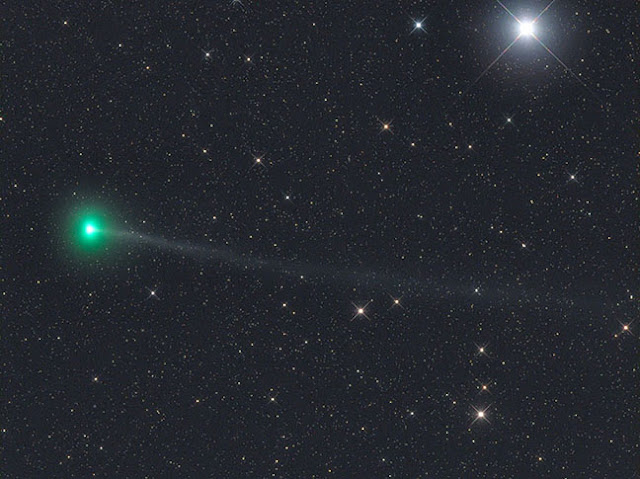Forget that. This fuzzball's already magnitude is +7–7.5 and a snap to see in 50-mm binoculars. I know because I got up Wednesday morning (March 29th) shortly before the start of dawn, pointed my 10×50 glass just below the figure of Equuleus, the Little Horse, and saw a small, dense ball of glowing fuzz without even trying. Comet 41P/Tuttle-Giacobini-Kresak — now circumpolar in Ursa Major — shines at a similar brightness, but being larger and less condensed, it's not quite as easy to see as Lovejoy.
A little more than a week ago, Comet Lovejoy glowed at magnitude +10–11; a few days ago it was at +9. Given its meteoric rise in brightness, observers are anticipating the comet to crest to magnitude +6 around perihelion as it describes a roller coaster arc across Pegasus and Andromeda. Twice it passes bright deep-sky objects: the bright globular cluster M15 on April 1st and the Andromeda Galaxy on April 20–22. Another easy time to spot it will be on April 8–9 alongside β Pegasi in the northwest corner of the Great Square.
With the Moon out of the picture until around April 7th, comet watchers have lots of dark-sky time to pursue this new find. Just remember that you'll only have a relatively short time before the start of dawn when the comet is highest in the eastern sky. Because of increasingly early sunrises, Lovejoy maintains a fairly constant 15° elevation at the start of morning twilight from mid-northern latitudes through mid-April. My observation was made at 5 a.m. about 10 minutes before dawn's first light. Look for a small, fuzzy spot that appears at first glance like an out-of-focus star.
Read Full Source Article at http://www.skyandtelescope.com/observing/comet-lovejoy-brightens-quickly-heads-north/


I Went out with my binoculars this morning to find the comet, however, it may have been lost in the twilight.
ReplyDelete